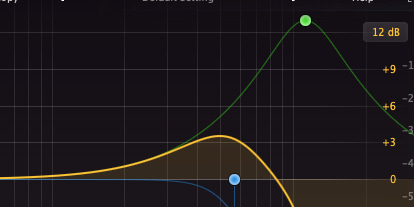Pair a boost and a cut, part I: high frequencies
Trying to find the right way to boost the top end of something can be maddeningly difficult sometimes, right?
Tell me if this sounds familiar: you’ve dialed in just the right amount of air on a vocal, or click on a kick drum. But in doing so you made it … brittle? Overly aggressive? Noisy? Just generally overloaded with supersonic garbage?
An excellent solution: pair the high-frequency boost with a high-frequency cut, in the form of a lowpass filter!
The trick is to use the HF boost to generate somewhat more excitement than the sound needs; and then set the LPF to contain it down to the proper amount.
For example, on Shannon’s voice, I routinely do the following combo:
- large bell-shaped boost at 15000Hz (+7dB or more)
- LPF at 13000Hz (12dB/oct)
On the kick drum in a punk/hardcore song I just mixed, I needed to get some click into the beater to help the sound speak properly on phone speakers. This proved to be the magic combo:
- +13dB (!) bell-shaped boost at 11000Hz
- LPF at 5700Hz (12dB/oct)
Let’s talk about that second example for a moment. Why on earth would I do a cut a full octave below where I did the boost? That sounds weird, right?
It’s because the edges of a +13dB bell-shaped boost extend pretty far to the left and right of the center frequency! So while the meat of the boost might be up at 11000Hz, the long tail of the boost extends down below 1000Hz.
And when you pair that nice long left edge of that bell-shaped curve with that 12dB/oct LPF cut at 5700Hz, what you’re left with is a lovely little asymmetrical poke centered at about +4dB at 5000Hz, with a smooth ramp down to the left and a more abrupt cutoff to the right. Which is a wonderful way to get more click out of a kick drum.
Study the pic below to see how this looks in practice!
Bell bottoms aren’t just for hippies — jamie




